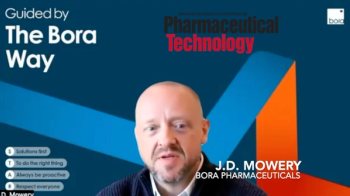
Pharmaceutical Technology Europe
- Pharmaceutical Technology Europe-07-01-2009
- Volume 21
- Issue 7
EU and US unite against rare diseases
Rare diseases represent an important area of unmet medical need.
Rare diseases represent an important area of unmet medical need (Table 1). Globally, it is estimated that 5000–8000 distinct rare diseases exist, with approximately 30 million people in the EU and 25 million people in the US suffering from such conditions.1–3 Most diseases are assessed by their impact on society as a whole and little attention is paid to rare diseases because of their low prevalence. Officially, rare diseases are defined as those affecting fewer than five in 10000 people in the EU and fewer than 200000 people in the US.3 These disorders pose serious difficulties for sufferers and their families.
Faiz Kermani
Patients often face long delays in getting an accurate diagnosis because many rare diseases are poorly characterized and doctors may not be familiar with them. Even after an appropriate diagnosis, patients often have few treatment options and usually have to wait years in the hope that a drug will be developed and approved for their specific condition. In the meantime, they are forced to seek expensive alternatives; however, they may experience problems with reimbursement.
Many pharmaceutical and biotech companies have been reluctant to engage in expensive research for rare diseases without assurance of a return on their investment. To be considered profitable, a treatment must be applicable to a certain number of patients during a certain number of years of commercial exclusivity. Progress has also been held back by the paucity of research on rare diseases and availability of scientific data.
Table 1: Challenges concerning rare disease management.
Nevertheless, there have been improvements in the regulatory environment and thanks to the continuing efforts of patient organizations to raise publicity, rare diseases now represent a growing area for research. The unmet medical need has also been officially recognized, leading to the introduction of orphan drug legislation in the US, Australia, Singapore, Japan and finally in the EU in April 2000. Other countries such as Canada, New Zealand, South Korea and India have appropriate legislation under consideration. Orphan medicinal products are those intended for the diagnosis, prevention and treatment of a disease so rare that developing these products through conventional legislation would mean they would never be sufficiently profitable for companies.
Orphan drug legislation in the US and Europe
In 1983, thanks largely to the lobbying efforts of patients, the US government introduced the Orphan Drug Act. This act contains incentives for the pharma industry to develop products for rare diseases and contained provisions to allow patients with a rare disease better access to treatments. The main incentives to industry are a 7year period of marketing exclusivity (which some industry observers have likened to a type of patent) and tax benefits on clinical trials between the date of orphan drug legislation and new drug application (NDA). The act has been further refined through Congressional amendments in 1984, 1985, 1988 and 2007.
To handle regulatory matters in this field, the FDA set up the Office of Orphan Products Development.4 To date, more than 1700 drugs and biologics have been designated as orphan drugs in the US, with more than 300 achieving marketing approval. In the decade prior to 1983, fewer than 10 orphan products were brought to market, showing that modest regulatory incentives can have a large effect on drug development.5
In the US, the National Organization for Rare Disorders (NORD) lobbies on behalf of patients with rare disorders and was established in 1983 by patients and families who worked together to get the Orphan Drug Act passed. It holds annual meetings where thought leaders from government, academia, the patient community and industry meet to help establish an agenda for action related to the R&D of orphan products on a national and international basis.5
Following the work of the French government in 1995 to convince the European Council of Health Ministers to vote in a resolution to develop orphan medicinal products legislation, a number of European countries began to pay closer attention to the issue of orphan drugs. One of the major lobbying groups for specific European orphan drug legislation is the European Organization for Rare Disorders (EURORDIS),6 a coalition of 340 rare disease organizations in 38 countries — 29 of which are EU member states. Besides hoping to see legal framework in place for orphan drugs, EURORDIS aims to obtain better co-operation between national patient organizations and to campaign for patients to receive reimbursements for their treatments.
In December 1999, the European Parliament and the Council adopted regulation (EC) No. 141/2000 on Orphan Drugs. The time lag for orphan drug legislation in Europe was partly because of the makeup of the EU, where healthcare responsibilities are shared between member state bodies. Nevertheless, as in the US, the adoption of orphan drug legislation had a noticeable impact on EU drug development. EURORDIS figures show that, since 2000, 560 drugs and biologics have been designated as orphan drugs, and 52 have achieved marketing approval.
The EMEA and its Committee for Orphan Medicinal Products (COMP) have facilitated implementation of the orphan drug legislation. The COMP is composed of one representative per member state, three EMEA representatives and three members to represent patients' organizations. The EMEA provides extensive support to the COMP through its secretariat by validating applications, providing summary reports of orphan applications and supporting meetings of COMP. For a medicinal product to receive designation as an orphan medicinal product in the EU, it is required to comply with criteria outlined in Article 3 of Regulation (EC) No.141/2000.
In the EU, the incentives to industry are slightly different to those of the US in that market exclusivity is for a 10 year period after the grant of a marketing authorization. This period of market exclusivity is subject to certain restrictions and can be reduced to 6 years if at the end of the fifth year the criteria outlined in Article 3 are no longer met; for example, if the product is shown to be sufficiently profitable to no longer justify market exclusivity.
Transatlantic co-operation
One of the exciting regulatory developments is greater co-operation between the US and Europe to harmonize regulations concerning orphan drug development. Both NORD and EURORDIS have been supporting moves in this direction. In 2006, a partnership between EURORDIS, the FDA and the EMEA resulted in a comparative analysis of EU and USdesignated and marketed orphan drugs. The data generated stimulated formal discussion between the FDA and the EMEA to harmonize the format and content of orphan drug applications at both agencies, speed up parallel designation, and develop common approaches for providing protocol assistance and other advice to industry.
One of the major outcomes so far has been the adoption of a common application form for sponsors seeking orphan designation of medicines in the EU and US. The agencies aim to reduce the burden of filing two separate requests when both the US and European markets are under consideration by a company. The common application form is flexible in that it contains a section for common information required by both the EMEA and the FDA, but also has sections for requirements unique to each agency.3 Both the FDA and the EMEA are confident that a greater degree of harmonization can be achieved, while still keeping the respective specificities of the EU and US regulations.5 For example, the agencies will still conduct independent reviews of such submissions.
Outlook
There has been considerable improvement in the field of rare disorders during the past 25 years as regulatory mechanisms designed to stimulate drug development are now in place in many countries. However, improvements still need to be made in other areas because legislation does not address the cost of drugs and who is going to pay for them.5 Similarly, more initiatives are needed to assist patients in finding information on rare diseases and to educate healthcare professionals about them.
Social media has dramatically improved access to information and has removed many of the traditional barriers for dialogue between patients;7 for example, RareShare is a unique social hub that builds communities for patients, families and healthcare professionals affected by rare disorders, and facilitates information exchange.8 Another development is the direct participation of patient organizations in public–private partnerships to manage the development of new drugs, rather than simply raising funds for background research. With continuing efforts such as these, there is new hope for meeting the ongoing needs of patients with rare diseases.
References
1. M. Kugler, Rare Diseases: Basic Information, 2008.
2. Rare Diseases.
3. EMEA, The European Union and the FDA working together to create Common Application for Orphan Designation for Medicines (2007), Doc. Ref. EMEA/557391/2007.
4. FDA, Developing Products for Rare Diseases & Conditions (2009).
5. National Organization for Rare Disorders: Partners in Progress Summit (Washington, DC, USA, 14 May 009).
6. Anon, About Orphan Drugs. European Organization for Rare Disorders (2007).
7. B. Comer, Compass utilizes social media for rare disease, MM&M (2008).
8. RareShare (2009).
Articles in this issue
over 16 years ago
Expression systems royalties battleover 16 years ago
Dynamic avalanching accurately assesses flowability and qualityover 16 years ago
Are we moving towards global patenting?over 16 years ago
The Pharma Top 50over 16 years ago
Penny-wise, pound-foolishover 16 years ago
Pharma's Facebookover 16 years ago
Thinking of theranostics?over 16 years ago
We invite you to Link inover 16 years ago
Human error costs industry billionsNewsletter
Get the essential updates shaping the future of pharma manufacturing and compliance—subscribe today to Pharmaceutical Technology and never miss a breakthrough.





